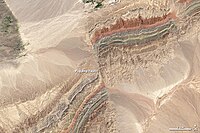
Photo from wikipedia
Abstract Evolution of permeability in deforming porous rocks implicitly depends on both, intrinsic rock properties (porosity, pore connectivity, pore shape, and pore size) and extrinsic environmental conditions (operating stress and… Click to show full abstract
Abstract Evolution of permeability in deforming porous rocks implicitly depends on both, intrinsic rock properties (porosity, pore connectivity, pore shape, and pore size) and extrinsic environmental conditions (operating stress and strain regimes). Traditionally, permeability evolution is estimated using phenomenological Kozney-Carmann type equation that involves intrinsic and extrinsic attributes. However, in such equations, microstructural changes are grossly approximated by macroscopic features like grain size distribution and rock mineralogy, and moreover, the two-way coupled relationship between intrinsic and extrinsic attributes is ignored. This study aims to address the permeability evolution rationally by employing a thermodynamically stable constitutive model that links the microstructural evolution, including grain crushing and pore collapse under various deformation regimes (elastic regime, localization regime, and post-localization regime). The results indicate that power-law type porosity-permeability relationship works well for different rocks. Finite element analysis performed on laboratory scale samples shows that permeability progressively evolves within a localized zone, although it appears that gross porosity evolution in rock is linearly proportional to the formation of discrete localization zone. In the post-localization regime, a reduction in tortuosity effect due to a reduction in the particle breakage rate is also observed. Outcomes of the study are presented as a permeability map in invariant stress-space (q-p space) that can be utilized for any practical design purpose.
Journal Title: Journal of Structural Geology
Year Published: 2020
Link to full text (if available)
Share on Social Media: Sign Up to like & get
recommendations!